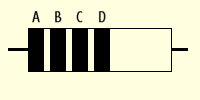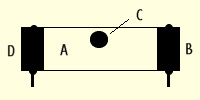Resistor Color Codes |
||||
|---|---|---|---|---|
| Color | 1st Digital (A) | 2nd Digital (B) | Multiplier (C) | Tolerance (D) |
| Black | 0 | 0 | 1 | - |
| Brown | 1 | 1 | 10 | 1% |
| Red | 2 | 2 | 100 | 2% |
| Orange | 3 | 3 | 1,000 | 3% |
| Yellow | 4 | 4 | 10,000 | 4% |
| Green | 5 | 5 | 100,000 | - |
| Blue | 6 | 6 | 1,000,000 | - |
| Violet | 7 | 7 | 10,000,000 | - |
| Gray | 8 | 8 | 100,000,000 | - |
| White | 9 | 9 | 1,000,000,000 | - |
| Gold | - | - | 0.1 (EIA) | - |
| Silver | - | - | 0.01 (EIA) | - |
| No Color | - | - | - | 20% |
Example: |
Resistor Diagrams |
|
|---|---|
| Axial Lead Resistor Band A may be wide on Axial Lead Resistors: 1: If band A is wide, the resistor is wirewound; 2: If band A is wide and there is a fifth band that is blue (to the right of band D), the resistor is wirewound and flame proof. This applies to Axial Lead Resistors only. |
 |
| Radial Lead Resistor |  |